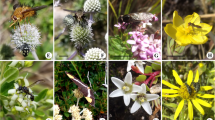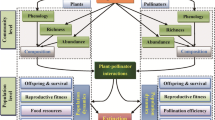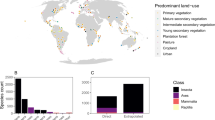Abstract
One outstanding and unsolved challenge in ecology and conservation biology is to understand how pollinator diversity affects plant performance. Here, we provide evidence of the functional role of pollination diversity in a plant species, Erysimum mediohispanicum (Brassicaceae). Pollinator abundance, richness and diversity as well as plant reproduction and recruitment were determined in eight plant populations. We found that E. mediohispanicum was generalized both at the regional and local (population) scale, since its flowers were visited by more than 100 species of insects with very different morphology, size and behaviour. However, populations differed in the degree of generalization. Generalization correlated with pollinator abundance and plant population size, but not with habitat, ungulate damage intensity, altitude or spatial location. More importantly, the degree of generalization had significant consequences for plant reproduction and recruitment. Plants from populations with intermediate generalization produced more seeds than plants from populations with low or high degrees of generalization. These differences were not the result of differences in number of flowers produced per plant. In addition, seedling emergence in a common garden was highest in plants from populations with intermediate degree of generalization. This outcome suggests the existence of an optimal level of generalizations even for generalized plant species.


Similar content being viewed by others
References
Aigner PA (2001) Optimality modeling and fitness trade-offs, when should plants become pollinator specialists? Oikos 95:177–184
Armbruster WS, Fenster CB, Dudash MR (2000) Pollination “principle” revisited: specialization, pollination syndromes, and the evolution of flowers. Det Norske Videnskaps—Akademi. I. Matematisk Naturvidenskapelige Klasse, Skriffe, Ny Serie, vol 39, pp 179–200
Arroyo MTK, Primack R, Armesto J (1982) Community studies in pollination ecology in the high temperate Andes of central Chile. I. Pollination mechanisms and altitudinal variation. Am J Bot 69:82–97
Ashman TL, Knight TM, Steets JA, Amarasekare P, Burd M, Campbell D, Dudash M, Johnston M, Mazer SJ, Mitchell R, et al. (2004) Pollen limitation of plant reproduction. Ecological and evolutionary causes and consequences. Ecology 85:2408–2421
Bascompte J, Jordano P, Melián CJ, Olesen JM (2003) The nested assembly of plant–animal mutualistic networks. Proc Natl Acad Sci USA 100:9383–9387
Bosch J, Blas M (1994) Foraging behavior and pollinating efficiency of Osmia cornuta and Apis mellifera on almond (Hymenoptera: Megachilidae and Apidae). Appl Entomol Zool 29:1–9
Colwell RK (2005) EstimateS—statistical estimation of species richness and shared species from samples, version 7.5, at http://www.purl.oclc.org/estimates
Colwell RK, Mao CX, Chang J (2004) Interpolating, extrapolating, and comparing incidence-based species accumulation curves. Ecology 85:2717–2727
Conner JK, Neumeier R (1995) Effects of black mustard population size on the taxonomic composition of pollinators. Oecologia 104:218–224
Devoto MD, Medan D, Montaldo NH (2005) Patterns of interaction between plants and pollinators along an enviromental gradient. Oikos 109:461–472
Faegri K, van der Pijl L (1979) The principles of pollination ecology, 3rd edn. Pergamon , Oxford
Fenster CB, Armbruster WS, Wilson PM, Dudash R, Thomson JD (2004) Pollination syndromes and floral specialization. Annu Rev Ecol Evol Syst 35:375–404
Fortin MJ, Gurevitch J (2001) Mantel test, spatial structure in field experiments. In: Scheiner SM, Gurevitch J (eds) Design and analysis of ecological experiments. Chapman and Hall, New York, pp 308–326
Gómez JM (2003) Herbivory reduces the strength of pollinator-mediated selection in the mediterranean herb Erysimum mediohispanicum: consequences for plant specialization. Am Nat 162:242–256
Gómez JM (2005) Non-additive effects of ungulates on the interaction between Erysimum mediohispanicum and its pollinators. Oecologia 143: 412–418
Gómez JM, Zamora R (1999) Generalization vs. specialization in the pollination system of Hormathophylla spinosa (Cruciferae). Ecology 80:796–805
Gómez JM, Zamora R (2006) Ecological factors that promote the evolution of generalization in pollination systems. In: Waser NM, Ollerton J (eds) Plant–pollinator interactions, from specialization to generalization. University of Chicago Press, Chicago, Ill., pp 145–165
Gómez JM, Perfectti F, Camacho JPM (2006) Natural selection on Erysimum mediohispanicum flower shape, insights into the evolution of zygomorphy. Am Nat 168:531–545
Gotelli NJ, Colwell RK (2001) Quantifying biodiversity, procedures and pitfalls in the measurement and comparison of species richness. Ecol Lett 4:379–391
Gotelli NJ, Entsminger DF (2005) EcoSim, Null models software for ecology, v 7.72 Acquired Intelligence Inc and Kesey-Bearm, at http://www.homepages.together.net/∼gentsmin/ecosim.htm
Herrera CM (1987a) Components of pollinator quality: comparative analysis of a diverse insect assemblage. Oikos 50:79–90
Herrera CM (1987b) Componentes del flujo génico en Lavandula latifolia Medicus: polinización y dispersión de semillas. An Jard Bot Madr 44:49–61
Herrera CM (1996) Floral traits and plant adaptation to insect pollinators, A devil’s advocate approach. In: Lloyd DG, Barrett SCH (eds) Floral biology. Chapman and Hall, New York, pp 65–87
Herrera CM (2005) Plant generalization on pollinators, species property or local phenomenon? Am J Bot 92:13–20
Hodkinson ID (2005) Terrestrial insects along elevation gradients: species and community responses to altitude. Biol Rev 80:489–513
Hortal JP, Borges AV, Gaspas C (2006) Evaluating the performance of species richness estimators, sensitivity to sample grain size. J Anim Ecol 75:274–287
Johnson SD, Steiner KE (2000) Generalization vs. specialization in plant pollination systems. Trends Ecol Evol 15:140–43
Jordano P, Bascompte J, Olesen JN (2006) The ecological consequences of complex topology and nested structure in pollination webs. In: Waser NM, Ollerton J (eds) Plant–pollinator interactions, from specialization to generalization. University of Chicago Press, Chicago, Ill., pp 173–200
Klein AM, Steffan-Dewenter I, Tscharntke T (2003) Fruit set of highland coffee increases with the diversity of pollinating bees. Proc R Soc Lond Ser B 270:955–961
Kremen C, Williams NM, Thorp RW (2002) Crop pollination from native bees at risk from agricultural intensification. Proc Natl Acad Sci USA 99:16812–16816
Knight TM, Steets JA, Vamosi JC, Mazer SJ, Burd M, et al (2005) Pollen limitation of plant reproduction: pattern and process. Annu Rev Ecol Evol Syst 36:467–97
Kunin WE (1997) Population size and density effects in pollination, pollinator foraging and plant reproductive success in experimental arrays of Brassica kaber. J Ecol 85:225–234
Longino JT, Coddington J, Colwell RK (2002) The ant fauna of a tropical rain forest, estimating species richness three different ways. Ecology 83:689–702
Magurran AE (2004) Ecological diversity and its measurements. 2nd edn. Princeton University Press, Princeton, N.J.
Medan D, Montaldo NH, Devoto M, Mantase A, Vasellati V, Roitman GG, Bartoloni NH (2002) Plant /pollinator relationships at two altitudes in the Andes of Mendoza, Argentina. Arct Antarc Alp Res 34:233–241
Moeller DA (2005) Pollinator community structure and sources of spatial variation in plant–pollinator interaction in Clarkia xantiana spp. xantiana. Oecologia 142:28–37
Motten AF, Campbell DR, Alexander DE, Miller HL (1981) Pollination effectiveness of specialist and generalist visitors to a North Carolina population of Claytonia virginica. Ecology 62:1278–1287
Ollerton J, Cranmer L (2002) Latitudinal trends in plant–pollinator interactions: are tropical plants more specialised? Oikos 98:340
Ollerton J, Johnson SD, Hingston AB (2006) Geographical variation in diversity and specificity of pollination systems. In: Waser NM, Ollerton J (eds) Plant–pollinator interactions, from specialization to generalization. University of Chicago Press, Chicago, Ill., pp 283–308
Price MV, Waser NM, Irwin RE, Campbell DR, Brody K (2005) Temporal and spatial variation in pollination of a montane herb: a seven-year study. Ecology 86:2106–2116
Proctor M, Yeo P, Lack A (1996) The natural history of pollination. Timber Press, Portland
Richardson DM, Allsopp N, D’Antonio CM, Milton SJ, Rejmánek M (2000) Plant invasions—the role of mutualisms. Biol Rev 75:63–99
Sahli HF, Conner JK (2006) Characterizing ecological generalization in plant–pollination systems. Oecologia 148:365–372
Sargent RD, Otto SP (2006) The role of local species abundance in the evolution of pollinator attraction in flowering plants. Am Nat 167:67–80
Schmitt J (1980) Pollinator foraging behavior and gene dispersal in Senecio. Evolution 34:934–943
Stebbins GL (1970) Adaptive radiation of reproductive characteristics in Angiosperms. I. pollination mechanisms. Annu Rev Ecol Syst 1:307–326
Steffan-Dewenter I (2003) Importance of habitat area and landscape context for species richness of bees and wasps in fragmented orchard meadows. Conserv Biol 17:1036–1044
Steffan-Dewenter I, Münzenberg U, Bürger C, Thies C, Tscharntke T (2002) Scale-dependent effects of landscape context on three pollinator guilds. Ecology 83:1421–1432
Vázquez DP, Aizen MA (2003) Null model analyses of specialization in plant–pollinator interactions. Ecology 84:2493–2501
Waser NM, Ollerton J (2006) Plant–pollinator interactions, from specialization to generalization. University of Chicago Press, Chicago, Ill.
Waser NM, Chitkka L, Price MV, Williams NM, Ollerton J (1996) Generalization in pollination systems, and why it matters. Ecology 77:1043–1060
Acknowledgements
We thank Pedro Jordano, Jeff Ollerton and Nick Waser for their useful comments on a preliminary version of this manuscript. We thank several specialists who kindly identified pollinator specimens: M. A. Alonso Zarazaga, R. Constantin, S. Fernández Gayubo, M. Goula, F. Gusenleitner, J. Háva, P. Leblanc, M. A. Marcos, J.C. Otero, A. Sánchez Ruiz, A. Sánchez Terrón, M. Schwarz, A. Tinaut, F. Vallhonrat and D. Ventura. The Ministerio de Medio Ambiente and Consejería de Medio Ambiente of the Junta de Andalucía granted permission to work in the Sierra Nevada National Park. The study was partially supported by the Spanish MCyT (BOS2003-09045, GLB2006-04883/BOS), and Junta de Andalucía PAI (RNM220 and CVI165).
Author information
Authors and Affiliations
Corresponding author
Additional information
Communicated by Florian Schiestl.
Rights and permissions
About this article
Cite this article
Gómez, J.M., Bosch, J., Perfectti, F. et al. Pollinator diversity affects plant reproduction and recruitment: the tradeoffs of generalization. Oecologia 153, 597–605 (2007). https://doi.org/10.1007/s00442-007-0758-3
Received:
Accepted:
Published:
Issue Date:
DOI: https://doi.org/10.1007/s00442-007-0758-3




